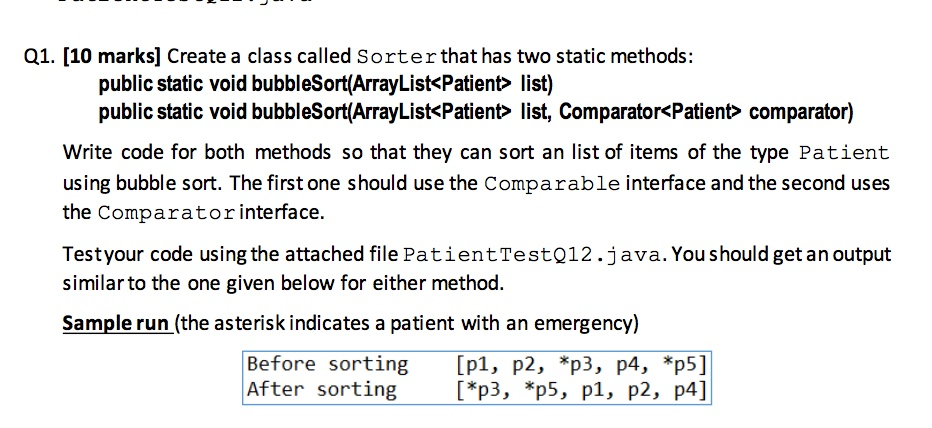Answered step by step
Verified Expert Solution
Question
1 Approved Answer
public class Patient implements Comparable { //attributes private int order; private String name; private boolean emergencyCase; //constructor public Patient(int order, String name, boolean emergencyCase) {

public class Patient implements Comparable
//attributes private int order; private String name; private boolean emergencyCase; //constructor public Patient(int order, String name, boolean emergencyCase) { this.order = order; this.name = name; this.emergencyCase = emergencyCase; } //compareTo public int compareTo(Patient other) { if(this.isEmergencyCase() && !other.isEmergencyCase()) return -1; //place this first else if(!this.isEmergencyCase() && other.isEmergencyCase()) return 1; //place other first else //if both are emergency or both are not emergency return this.getOrder()-other.getOrder(); //place smaller order first } //getters and setters public int getOrder() { return order; } public void setOrder(int order) { this.order = order; } public String getName() { return name; } public void setName(String name) { this.name = name; } public boolean isEmergencyCase() { return emergencyCase; } public void setEmergencyCase(boolean emergencyCase) { this.emergencyCase = emergencyCase; } public String toString() { return (isEmergencyCase()?"*":"") + name; } }
import java.util.Comparator; public class PatientComparator implements Comparator{ public int compare(Patient p1, Patient p2) { if(p1.isEmergencyCase() && !p2.isEmergencyCase()) return -1; //place p1 first else if(!p1.isEmergencyCase() && p2.isEmergencyCase()) return 1; //place p2 first else //if both are emergency or both are not emergency return p1.getOrder()-p2.getOrder(); //place smaller order first } }
import java.util.ArrayList; public class PatientTestQ12 { public static void main(String[] args) { ArrayList list = new ArrayList(5); list.add(new Patient(1, "p1", false)); list.add(new Patient(2, "p2", false)); list.add(new Patient(3, "p3", true)); list.add(new Patient(4, "p4", false)); list.add(new Patient(5, "p5", true)); //before sorting System.out.printf("%-15s%25s ", "Before sorting", list); //should be [p1, p2, p3, p4, p5] //try bubble sort methods for Q1 //Sorter.bubbleSort(list); //Sorter.bubbleSort(list, new PatientComparator()); //other sort methods for Q2 //Sorter.selectionSort(list); //Sorter.insertionSort(list); //after sorting System.out.printf("%-15s%25s ", "After sorting", list); //should be [p3, p5, p1, p2, p4] } } Q1. [10 marks] Create a class called Sorter that has two static methods: public static void bubbleSort(ArrayList Patient> list) public static void bubbleSort(ArrayListStep by Step Solution
There are 3 Steps involved in it
Step: 1

Get Instant Access to Expert-Tailored Solutions
See step-by-step solutions with expert insights and AI powered tools for academic success
Step: 2

Step: 3

Ace Your Homework with AI
Get the answers you need in no time with our AI-driven, step-by-step assistance
Get Started


